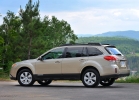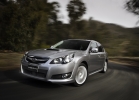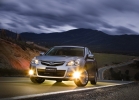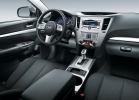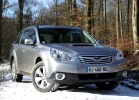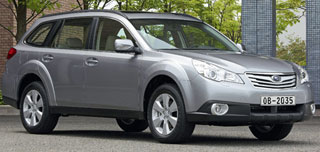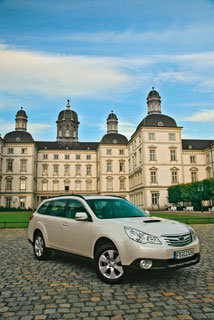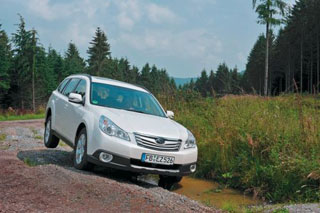Subaru Outback test drive since 2009
Twice universal station wagons
The ideology of the creation of such cars is simple and effective for a regular passenger station wagon is equipped with an all -wheel drive transmission and, due to changes in the suspension, rises above the ground to the road clearance of about 200 mm. In recent history, this method has discovered (there were examples in the past, including in Russia), Subaru. Soon her example was followed by Volvo, Audi, Renault ...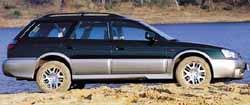
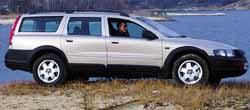
There is no doubt that in the near future, such slightly SUVs will appear among many car manufacturers. And the point is not only in the relative simplicity of their development and organization of production, but also in the fact that most of the buyers of all -terrain vehicles are not necessary in essence. Undoubtedly inferior to traditional jeeps in off -road abilities, they are significantly more convenient on road roads. The reason for this test was two new products: Subaru Legacy Outback received a new modification with a three-liter 6-cylinder engine, and the Volvo V70 Cross Country was completely updated. Both cars are quite close to each other in terms of dimensions, and in capacity, and by the possibilities of a power unit. A significant difference only in the cost of Volvo percent is 20 more expensive.
If we consider the structural features of cars, then here you need, first of all, to contact the engines installed on Volvo and Subaru. In Volvo, the traditional 5-cylinder motor with low-pressure turbocharges gives almost the same power (200 hp/6000 rpm) as the Subaru engine (209 hp/6000 rpm), but on The torque schedule provides a maximum of 285 Nm in the latest revolutions from 1800 to 5000. The new three-liter opposite 6-cylinder engine is no less traditional for Subaru by non-boost, but by a working volume, and therefore a maximum of 282 nm moment is reached at the point of 4400 rpm. min. In our case, both cars were equipped with hydromechanical automatic gearboxes, in 5-speed Volvo, in 4-speed Subaru. However, these cars are also produced with simple mechanical boxes. But in Legacy Outback, the mechanic is installed only with a 2.5-liter engine. Interestingly, in this case, Subaru is equipped with a lowering gear.
The device and operation of all -wheel drive systems in Volvo and Subaru are also very different from each other. Subaru torque is constantly heard between the front and rear wheels. The role of the center differential is performed by a multi -disc wet clutch adjustable by an electronic unit. The Volvo system is simpler instead of the center differential, the WISKOFT is built in, transmitting the moment to the rear wheels only when slipping the front ones. Therefore, with a straightforward movement without boxing, Volvo is almost anteroplative.
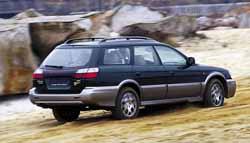
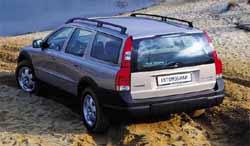
Appearance, interior
Despite the fact that Cross Country and Outback make a completely different external impression, they cannot be attributed to outstanding achievements of automobile design, or to obvious failures. Surely my comparative assessments will cause a lot of disputes, however, it is probably not worth looking for objective truth in such discussions. The appearance of Volvo is more expressive and characteristic. The abundance of black finishes (bumpers, border of the radiator grille, eyebrows of wheel niches, door pads) gives the car a certain, slightly rough, brutality. Subaru's appearance is more concise and more elegant. Here, and to no less than that of Volvo, branded features are preserved. At the same time, the contrasting lower plastic bandage of the body (bumpers, door pads, thresholds and wheeled niches) cannot be called especially elegant.
The design of the interiors of Subaru and Volvo also makes a different impression. In both cases, high -quality soft plastics are mainly used for the decoration, and for seats and leather, however, the front panel of the Volvo interior looks more modern, while Subaru is made rather in a classic style. There are no serious complaints about the convenience of the location at the wheel, but there are comments. So, Subaru does not have enough longitudinal adjustment of the steering column, but there is a complete set of seats's electroregies. Volvo, on the contrary, has both rudder adjustments, but the driver's seat is regulated only manually. This could not be considered a disadvantage if it would not need to be released either to bounce or get out of the car to raise the seat.
The space in the rear seat of both Cross Country and Outback is quite worthy of E. Volvo cars have a slight advantage in the width of the cabin, but Subaru sitting behind are provided with their own, second hatch in the roof. The luggage departments of Volvo and Subaru are very close in terms of dimensions, and in shape, and in volume both with raised and with folded rear seats. Here, a useful advantage of Volvo is a grate that separates the trunk from the cabin, which can be installed both behind the rear and front seats. It is very convenient for protection against highly wrapped goods, and for isolation of the dog.
Acceleration dynamics, brakes
Volvo Cross Country had a very correct acceleration dynamics. At an active start from the place, it does not slightly to the expected one from the 200-horsepower engine, which in general is not clear the car is not easy, and the automatic machine softens the process. So do not count on an explosion of emotions. But in the movement, the car reacts almost instantly to Kick-Down, accelerating very briskly, and without any jerks and twitching. And with quick overtaking, it is not necessary to regret the absence of manual switching. By the way, a low -pressure turbocharged low pressure provides not only excellent traction in a wide range of revolutions, but also the absence of turbine surges between pressing the accelerator pedal and the motor reactions. In general, the Cross Country power unit works very balanced and efficiently.
Subaru has a different picture. When the engine feels a whip called Kick-Down, it provides acceleration no less intense than that of Volvo. The thing is that the delay between pressing the pedal and the reaction of the power unit is too noticeable. It is not so great, but against the background of Volvo is obvious. If you still talk about machine guns, then Subaru and Volvo clearly lack the possibility of moving into a manual control mode of an automatic box (similar to Tiptronic on Audi). Moreover, the manual regime is important not so much for acceleration as for braking by the engine, or rather, for the competent passage of turns in each phase of the winding section of the road, the desired transmission is provided and the use of the brakes is minimized. As for the work of brake systems, there are no significant complaints about Subaru, but Volvo showed an unexpected hole. Moreover, during braking with low and medium intensity, everything happens normally, and the pedal force corresponds to the expected slowdown. But with emergency braking, the pedal falls slightly and loses information content.
Controllability
In control, as in appearance, branded traditions of both Subaru and Volvo were quite clearly manifested, and not in favor of the latter. On the example of Impreza, Legacy and even Forester models, a small Japanese company taught us to create cars for the driver. The Volvo models, on the contrary, have developed for decades the image of safe vehicles for passengers. With this negative image, the company fought quite successfully throughout the 90s, but some birthmarks have not yet been bred. In the case of CROSS Country, we are talking about an almost complete absence of the reactive effect of steering. The driver is isolated from the road and, by effort on the steering wheel, cannot judge either the trajectory along which he moves, nor the adhesion properties of the track coating. We add to this the low accuracy of the steering in the central zone and, as a result, the need for constant steering corrections of the course. An important nuance, offended also because the rest of the car behaves with dignity does not heal much and relieves reliably to the road in corners.
The effort on the steering wheel is also not large, but, not as an example of Volvo, reliably transmitting the necessary information to the driver, changing depending on the lateral accelerations and the condition of the coating. And although Legacy Outback is inferior to the usual low Legacy in the severity of reactions, the car still gives pleasure to control. As for the stability of high -speed straightforward movement, Outback is outside of criticism.
Smoothness, noise level
Both cars have a very good smooth stroke. Compared to low modifications of conventional Volvo V70 and Subaru Legacy, they demonstrate a significantly better energy intensity of the suspension, that is, the ability to swallow large irregularities in the road. In the dispute between themselves, neither Outback nor Cross Country showed decisive advantages. Outback is a little better processing very small joints of the road surface, Cross Country perceives more grill -grower. Both cars do not annoy the noise either aerodynamic, motor or road. But the leader is in noiseless Volvo. Its engine, up to high speeds, is practically not heard. The Subaru engine is quite clearly heard, but its sound is more correct to call it not a noise, but unobtrusive musical accompaniment.
Cross -country ability
Despite the distrust of the off-road abilities of our wards, we still decided to climb loose sand at the bottom of the old career. And both cars were pleasantly surprised to confidently move forward, even after provocative stops. Honestly, we would not dare to climb into such porridge even on all -wheel drive, but low base Subaru Legacy. We can assume that outback and Cross Country justified their purpose. They will really help you, for example, in winter to get to a summer house on snow. Just do not demand from the cars overcoming strong overclocks of the surface, because the critical corners of the congress, entry and longitudinal patency are only a little more than that of ordinary cars. Moreover, with respect to the corners of the congress and entry of Subaru, Volvo loses a little. However, Subaru has its own advantage of a constant all -wheel drive. In order to earn the rear wheels, Volvo needs to slip the front ones, and this, as we have seen, is enough for them to steal.
Results
Before determining the winner, it is necessary to answer the question, it may be rhetorical: do you need similar universal universals in general? The answer is yes, we need it, but with a reservation: if you periodically have to face a primer blurry with rains or with an access road not cleared from snow. That is, to get into quite frequent situations when the passage of a passenger car is clearly not enough, and the all -heartiness of a real jeep is not yet required. Despite the obvious dissimilarity, neither the Volvo V70 Cross Country nor Subaru Legacy Outback showed an unconditionally decisive advantage, if one does not count, of course, that Subaru is about 8 thousand dollars cheaper. Not to mention the subjective assessment of design and secondary pro and against, the most tangible differences are as follows: the advantage of Volvo in the dynamics of acceleration and the winning of Subaru in controllability.
P.S. In the table of technical characteristics for comparison, we introduced diesel, rather than gasoline modification of the Audi Allroad, since it is closer to tested cars and in terms of power.
Roman Sergeev
Photo by Alexander Nozdrin
How do they look?
Nikita Rozanov
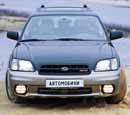
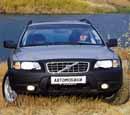
Outside:
Despite the fact that the Subaru design is only one year older than Volvo, the Swedish car is perceived much more fresh, and as a result it begins to seem that two cars are separating a much larger time interval. Both cars are special modifications of ordinary station wagons: Subaru Legacy Station Wagon, and the VOLVO VOLVO V70. Designers carried out a peculiar settings for increased cross-country ability: as a result, Volvo resembles the output shoes made of genuine leather, the owner of which was forced, protected from slush, to put on thin and stylish galoshes on them, Subaru looks a clear athlete-older, kneading in a slightly variegated, but expensive training suit.
The image of Cross Country is formed by several plastic details left naked and not painted in the color of the body. Therefore, scratching them with branches of a roadside shrub will not be so offensive. So, for example, bumpers, mirrors and the front panel of the body are protected, the black matte surfaces of which make them similar to very beloved Americans with muzzles and nacerrals who hang enthusiasts of suburban trips on their cars, which gives the head VOLVO first of all to focus on the tastes of the new Sveta. Protective plastic overlays were also obtained by the edges of the wheeled arches, the bottom of the doors, as well as the threshold. Under the front bumper, you can see a wide silver ski that imitates a powerful steel plate of crankcase protection of cars involved in rally-raids. As a result of all this, the color and facultic variety of Volvo is too risky brings its design to the verge, beyond which the destruction of the whole perception of the form begins.
At first glance, the Subaru design is the exact opposite of the VOLVO off -road setting. Expressive coloring the dark top of the light bottom can cause both associations with the appearance of typical representatives of the class of modern SUV and the cult cars for America Pace Car, which serve the races in Indianapolis. In addition, with a more careful look, Subaru plastic and style can be safely characterized as more advanced in aerodynamics, and not at all in off -road utilitarianism. The lignified arcs of the trunk attachment and the predatory forms of the front spoiler, which are located, are located, which are located from the arsenal of a rally equipment, are located on such an image. The sidewall of the body on 2/3 is covered with a silver plastic lining, in the lower part of which, immediately behind the front wheel, as a result of aerodynamic configuration, a small but stylish spoiler is designed to reduce body pollution. The faces of both cars are quite individual, although Subaru cannot boast of bright family features that are emphasized in the design of the VOLVO radiator cladding. Both cars and behind thanks to proprietary optics are recognizable. In Volvo, it is traditionally made to the full height of the universal body, Subaru has the similarity of its shape with the rear lights of the previous Legacy series. The shape of the wheel discs is quite utilitarian in CROSS Country and is too decorative for Outback. The latter will clearly affect when driving on the off -road, such wheels are easy to score with dirt, but it is very difficult to wash.
Bottom line: Volvo Cross Country Fresh and original design, not devoid of traits of proprietary affiliation. Fully meets the utilitarian purpose. However, the tone contrast of dark functional details and a light body reduces the feeling of integrity of the shape.
Assessment **** (4 stars)
Subaru outback is a whole and easily recognizable look. The style may seem too decorative and expressive, which complicates the interpretation of the purpose of the car.
Assessment **** (4 stars)

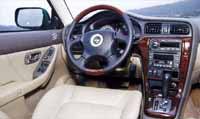
Inside:
Here the moral aging of Subaru design is manifested, and, for example, the Volvo instrument panel differs from the Subaru panel, as a refined aesthetic equipment of Bang & Olufsen from the national style of Samsung. Inside, Subaru is as two-flowing as outside: the light bottom resembles more expensive cars of the 90s. The Volvo design is impeccably clean and functionally verified, and the styles of the climate control unit on the central console and individual details of expensive radio equipment are really very close to each other. Subaru upholstery also looks outdated. The panel is flat and inexpressive, the only decoration contrasting combination of flowers of finishing materials. In addition, in its design, the part archaic consists of several parts: a window sill and a panel with a prefix armrest. The Volvo door is perceived by a single detail and looks like a modern sculpture, and an elegantly integrated into its surface, an insert of a material of a different color demonstrates great possibilities of factory technologists. From the loss in this nomination, Subaru does not save even a large insert under a tree on the central console and the steel plate of the curtains of the automatic transmission. All these techniques have long been in the category of mass decorative design, and only the most lazy stylists do not use it.
The trunk of a bicom -free universal is an integral part of its inhabited space, and therefore the cargo compartment of modern utilitarian cars is so comfortable and is finished with no less thoroughness than the instrument panel. The Subaru ceiling is equipped with two hatches and in this regard has a more complex relief of the shape of the upholstery. The cut and the finish of the seats are characteristic of both manufacturers, the Volvo seats are rational, and at Subaru they give out the orientation of Outback to the tastes of the North American market.
Bottom line: Volvo Cross Country is a modern and very whole design with carefully designed details and finely selected finishing materials.
Assessment ***** (5 stars)
Subaru Outback Dynamic design and comfortable decoration style. However, the overall impression reduces morally outdated solutions.
Assessment *** (3 stars)
How they sound:
Maxim Rakitin
As expected, the musical parts of the tested station wagons turned out to be quite worthy of the cars themselves.
Volvo Cross Country
At the first glance at the instrument panel and the front doors, we, to our joy, found as many as seven holes for the speakers. This means that in the audio system Volvo there is a central channel. In confirmation of this, we found on the buttons of the head device the inscription Dolby Surround 3-CH. The application is serious! There are also speakers in the rear doors, one in each, total of the total number of speakers in the Cross Country cabin is nine.
The head device is a combination of tuner, cassette and disk players. Judging by the size and monumentality, this complex design is not subject to replacement. The head device also has remote sound adjustment located on the steering wheel. The operating manual says that the head has 45 watts for each channel. The signal from the built -in amplifier enters the digital sound processor and an external amplifier, from where the speakers with a capacity of 120 to 175 watts. The processor is controlled from the head device panel. Dolby Surround can be turned off, and then the sound will turn into a regular stereo into four channels. Adjustments of the timbre, balance, fader and volume are carried out by rotating handles, the volume handle is large and comfortable, but all the rest are small, and it is better to use them during the parking. All the rest is entrusted to functional keys with clear symbols. It is pleasant to note that each function has its own button, and they are not overloaded with unnecessary information.
The matrix display is small, but long and easily read, only the lack of information about the volume of sound is upset. The tuner operates in the AM, FM ranges (only in the European version 87.5-108 MHz) and is equipped with RDS with PTY and TA, TF modes. Thanks to the active antenna in the side glass of the luggage compartment, the reception is confident. For each range there are three memory banks. The configuration is carried out in automatic mode (from a stronger signal to weak) and in manual. The automatic memorization process takes no more than 20 seconds, and the tuner clings to almost all radio stations available in this area.
Cassette part with complete logical control, Dolby B noise reduction system and author. He willingly swallows the cassette and immediately begins its reproduction. A search for pauses and listening to the beginning of each composition is possible. The release is slightly thoughtful, but the cassette goes softly and far enough from the nest. The controller of the CDs is carried out by the same buttons as the cassette, the exception is the emission button. The disk is placed in the nest, and the device immediately draws it inside. The laser head is silent and quickly finds the desired path. In addition to search and pass, Sidyuk can endlessly lose the disk, as well as the first 10 seconds of each track.
The vibration resistance of the Volvian system can be estimated at the hard five out of five. Not a single bump, but, believe me, there were a lot of them, the player with a buffer memory was confused for ten seconds. A powerful, juicy sound with a clear bass and a perfectly worked out middle will please the hearing of even the most avid music lover. The Dolby Surround shutdown slightly changes the sound picture, the average channel turns off, and a void forms in its place. But even the sound does not get worse. The system will be very pleasant for lovers of rock and dance music, and connoisseurs of jazz and classics will appreciate the balance and wealth of the musical palette of Volvian music.
Subaru Outbek
The sound filling of this car consists of a magnet of size 2 din with a tuner, a cassette and a player of CD. Musical space is formed by frontal separate and rear coaxial acoustic systems. The operating manual opened a veil of secrets over the manufacturer of music for Subaru. Simple single -day systems are supplied by VDO (previously known as Philips Car Audio), and more expensive devices on Clarion conscience.
Part of the front panel is made, for security purposes, removable. The luminescent screen is visible very well, even the sun does not interfere with the rear window. The screen simply changes color, and the characters remain easily readable. Large keys, which, however, are slightly overloaded with functions, all the controls are managed. As in the first case, the passengers of Subaru were given complete freedom of choice of sound source. The built -in amplifier of the head device has a power of 4 each 50 watts at the output. The front separate speakers swing up to 150 watts, and the rear to 100. From the point of view of acoustics, this is correct, since it is frontal speakers that form a sound picture. The tuner equipped with the RDS operates in three ranges AM, FM and SW. The search is automatic and manual. Automation remembers the station from a strong signal to the weak. The reception is very good and confident, and if the signal weakens, then when receiving the FM stations, the tuner automatically switches to a mono mode. The active antenna is located on the left glass of the luggage compartment.
The cassette player is completely logic. The cassette enters the nest smoothly, and it practically does not need to be pushed. A light buzz of a ribbon -melting mechanism at the time of loading does not cause much trouble. The cassette player with the authors, repetition and the search has just an exemplary sound, I must say thanks to the magnetic head with the permalloal coating. Although the player is not equipped with any noise reduction system, there are practically no noise. The release of the cassette occurs almost like a cassette’s video recorder comes out smoothly and with dignity. However, over time, this may get bored too long the process itself turns out to be too long.
In addition to the usual functions, the search for the Picture of CDs is also equipped with a pause and free reproduction of the disk with the possibility of repetition. By connecting Chainer, the owner of Subaru will get the opportunity to choose the paths that he would like to listen to. Sidyuk control is very simple and convenient: the release and loading are fully automated and do not cause any complaints. As for the resistance of the player to the blows, here Subaru is also on top. The buffer can contain as much as 20 seconds of the track played! The sound is powerful and juicy. The bass is somewhat raging, especially when the subtle is turned on, but it is easy to get rid of a simple adjustment or disconnection of the Loud function from this disadvantage. The classic compositions recorded on the CD sounds excellently. A powerful drive and the sound of the surrounding power are not needed here, a special study of each instrument is important here, and this is fully ensured by the Subarovsk sidyuk
Source: Cars

